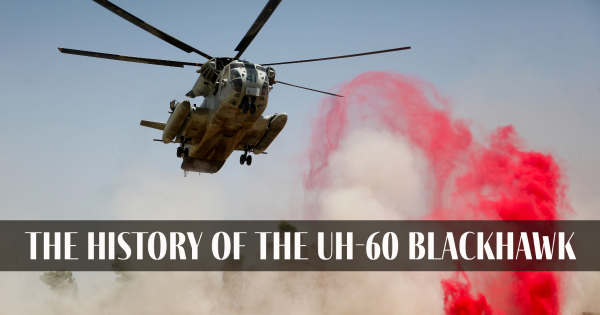Trip Ready: Guaranteeing Optimum Condition for Your UH 60 Helicopter
Trip Ready: Guaranteeing Optimum Condition for Your UH 60 Helicopter
Blog Article
Comprehending the Mechanics and Engineering Behind Uh 60 Helicopters
The UH-60 helicopter, frequently recognized as the Black Hawk, stands as a pinnacle of contemporary rotorcraft technology, embodying a blend of robust design and elaborate technicians. As we peel off back the layers of the UH-60's layout, a world of complex systems and meticulous engineering comes to light.
Background of UH-60 Helicopters
The history of UH-60 helicopters traces back to the late 1970s when the USA Military looked for a flexible and sophisticated utility helicopter to change its aging fleet. In feedback to this demand, the Sikorsky Airplane Company created the UH-60 Black Hawk helicopter. Presented in 1979, the UH-60 promptly ended up being a staple in armed forces procedures as a result of its remarkable abilities.
The UH-60 was made to stand out in a range of goals, including troop transport, clinical evacuation, digital warfare, and unique operations. Its capability to adjust to different functions made it a beneficial possession to the united state Army and other military forces around the globe
Over the years, the UH-60 platform has undertaken several upgrades and variants to improve its performance and equal progressing mission demands. These helicopters have seen substantial solution in conflicts such as the Gulf Battle, Afghanistan, and Iraq, showcasing their integrity and versatility in varied functional settings. The UH-60's abundant background is a testament to its enduring tradition as a top utility helicopter.

Engine and Power Solutions
Utilizing sophisticated propulsion technology, UH-60 helicopters are outfitted with advanced engine and power systems to guarantee optimum efficiency and dependability in a variety of operational circumstances. The UH-60, commonly referred to as the Black Hawk, is powered by 2 General Electric T700-GE-701D engines, each qualified of delivering up to 1,940 shaft horse power. These turboshaft engines offer the necessary thrust for the helicopter to lug out its missions properly, including army transportation, clinical discharge, and combat assistance.

Blades System and The Rules Of Aerodynamics
Just how do the blades system and aerodynamics of UH-60 helicopters contribute to their operational efficiency and trip capacities? The rotor system of the UH-60 helicopter plays a critical function in providing lift and propulsion.
Aerodynamics likewise play an essential duty in the efficiency of UH-60 helicopters. The structured body and rotor blade layout minimize additional resources drag, allowing the helicopter to achieve higher speeds and far better fuel efficiency. The wind resistant design of the UH-60 also adds to its ability to run in diverse environmental conditions, including hot temperature levels and high elevations.
Avionics and Trip Control Solution

In its detailed control with the rotor system and the rules of aerodynamics of UH-60 helicopters, the avionics and trip control systems develop an important network of technologies forming the airplane's functional capacities. Avionics encompass the digital systems made use of for communication, navigation, and monitoring numerous aircraft features. In the UH-60, these systems include digital screens, communication radios, GPS navigating, weather condition radar, and autopilot systems. These avionics systems offer essential information to the pilots, boosting situational recognition and making sure safe and effective operation of pop over here the helicopter.
The flight control systems of the UH-60 are in charge of converting the pilot's inputs right into the proper adjustments to the rotor system, making certain secure flight and ability to move. These systems include hydraulic actuators, servos, and computers that function with each other to regulate the tail and main blades, in addition to other flight control surfaces. By exactly managing the helicopter's trip dynamics, these systems allow pilots to perform a wide variety of missions, from transportation and search-and-rescue to fight operations, with accuracy and confidence.
Function and Applications in Aeronautics
Avionics systems in UH-60 helicopters include a range of electronic systems that aid in navigation, interaction, tracking, and managing different aircraft functions. These systems consist of digital screens, autopilot systems, communication radios, General practitioner navigating equipment, and weather radar. Furthermore, these systems incorporate safety attributes such as auto-pilot settings, terrain awareness warning systems, and stability enhancement systems to enhance the overall safety and operational capacities of the UH-60 helicopters in various objectives, including troop transportation, medical evacuation, search and rescue, and airborne firefighting.
Conclusion
To conclude, the UH-60 helicopter is a flexible aircraft with a rich history and advanced engineering. Its engine and power systems, rotor system, aerodynamics, avionics, and flight control systems all interact to make it a dependable and reliable maker. The UH-60's duty and applications in air travel are large, varying from military procedures to search and save missions. Its proceeded development and use demonstrate its significance in the field of aviation (uh 60).
In its detailed sychronisation with the blades system and the rules of aerodynamics of UH-60 helicopters, the avionics and flight control systems develop an important network of technologies shaping the aircraft's operational capacities.The trip control systems of the UH-60 are liable for translating the pilot's inputs right into the suitable changes to the blades system, ensuring steady flight and maneuverability. Avionics systems in UH-60 helicopters incorporate a range of more information electronic systems that aid in navigating, interaction, surveillance, and managing different aircraft features. Additionally, these systems integrate safety attributes such as autopilot modes, terrain recognition cautioning systems, and security augmentation systems to boost the total safety and security and functional capacities of the UH-60 helicopters in various missions, consisting of troop transport, medical discharge, search and rescue, and airborne firefighting.
Its engine and power systems, rotor system, aerodynamics, avionics, and trip control systems all function together to make it a reliable and reliable maker.
Report this page